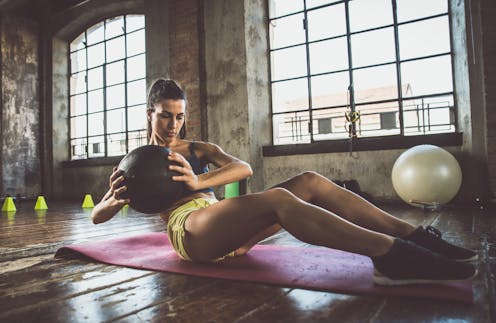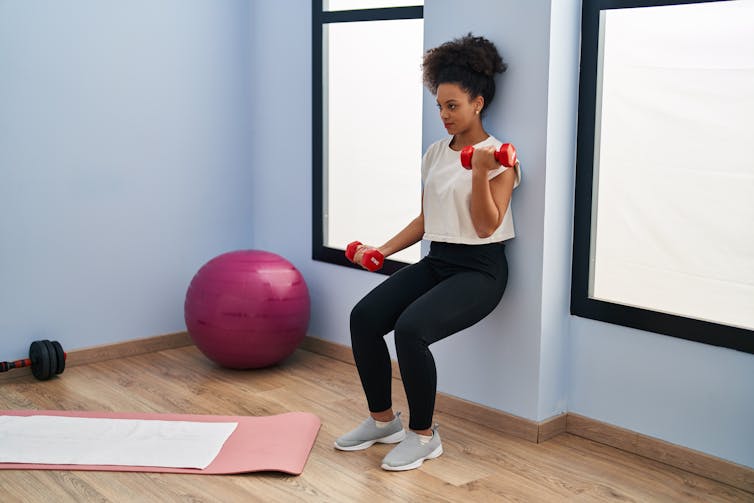
Social media is full of fitness trends. While some of these are outlandish or verging on dangerous, others are actually helpful.
Take the “shy girl workout” trend. While this has been floating around the internet since late 2022, it continues to be popular online.
The premise of shy girl workouts is simple. They are designed to use minimal space in the gym and only a couple of pieces of equipment – such as a pair of dumbbells.
They’re targeted at women who may be beginners or who have anxiety about going to the gym, but still want to get a good resistance workout in without having to move around the gym floor or use complicated weight machines.

This article is part of Quarter Life, a series about issues affecting those of us in our twenties and thirties. From the challenges of beginning a career and taking care of our mental health, to the excitement of starting a family, adopting a pet or just making friends as an adult. The articles in this series explore the questions and bring answers as we navigate this turbulent period of life.
You may be interested in:
‘It felt like how I looked was part of the decoration’: how getting wed affects women’s body image
Body dysmorphic disorder: what to know about this mental health condition
How running can help you cope with stress at work
While the initial benefit of these workouts is that they can help you get over your fear of going to the gym, they may also have the more long-term benefit of empowering users and helping them feel more confident about being in the gym.
Gym anxiety
There’s a great deal of research showing that women face societal pressures to attain the perfect fit and toned physique. This pressure is particularly acute in exercise environments (such as the gym) where people’s bodies are the focus. Women who feel they don’t have the ideal body may therefore feel uncomfortable going to the gym.
Many women often feel like they’re being “looked at” when they’re in the gym. This feeling is known as “hypervisibility”, and tends to happen when people think they’re different from others in a particular social setting.
In the case of the gym, hypervisibility occurs due to the male-dominated nature of the space, making women feel like they stand out. This feeling of hypervisibility can worsen women’s existing body insecurities, and may encourage some women to avoid the gym altogether.
Weight stigma has also been found to be particularly prevalent in exercise settings. One study found that people who were overweight experienced harassment and ridicule while exercising. As such, some women may avoid the gym entirely for fear of ridicule.
But body insecurities aren’t the only reason women feel intimidated by the gym.
Social scientists have long shown that the geography of the average gym floor is highly gendered. For example, one study found that gyms have distinctive gendered “zones”, with the weights area seen as “masculine” and the cardio machines and stretching area seen as “feminine”.
Many women in this study also reported that they felt judged and even sexualised when they tried to use the weights area in their gym. So, it’s understandable why women may want a workout that allows them to use weights in an area of the gym in which they feel comfortable.

Research also tells us that many women find it hard to take up space in public places. “Taking up space” is about making yourself visible and feeling like you belong in the setting you’re in.
When people don’t feel able to take up space, it means they do not feel entitled or confident about being visible in a public or a social situation. Many women feel this way in the gym.
Since shy girl workouts only use a small amount of space in the gym, it may help women to feel more comfortable while working out.
This, coupled with experiences of sexual harassment in gyms, could explain why some women feel anxious in these environments – and why they’re keen to find ways to be in these places without feeling intimidated.
Building gym confidence
While shy girl workouts won’t necessarily tackle all of the reasons a person may feel anxious about going to the gym, there are still many positives to the trend.
These workouts tend to be aimed at beginners, making them accessible to people who may otherwise find “gymtimidation” to be a major barrier to them working out. It may also help women to get more used to the gym environment, and eventually get the confidence to try different exercises or use new equipment.
Another benefit of the shy girl workout trend is that it acts as a digital form of social support. When women share their shy girl workouts online, it not only helps give other women ideas about the kind of workouts they can do, it also normalises experiences that are common to many women.
These posts and the comments they attract create a forum where they can publicly discuss their feelings of anxiety and discomfort in exercise spaces. Having access to this support may help women feel more empowered and less alone in their experiences of gym anxiety, which may improve their overall wellbeing and confidence.
Importantly, the shy girl trend meets women where they are by acknowledging the gendered pressures they face in gyms and offering practical solutions. Addressing the underlying causes of women’s gym anxiety remains key.
But shy girl workouts are also a collective response to inequality in exercise spaces that may provide women with a feeling of support while they grow more confident about going to the gym.
Hester Hockin-Boyers does not work for, consult, own shares in or receive funding from any company or organisation that would benefit from this article, and has disclosed no relevant affiliations beyond their academic appointment.
This article was originally published on The Conversation. Read the original article.







